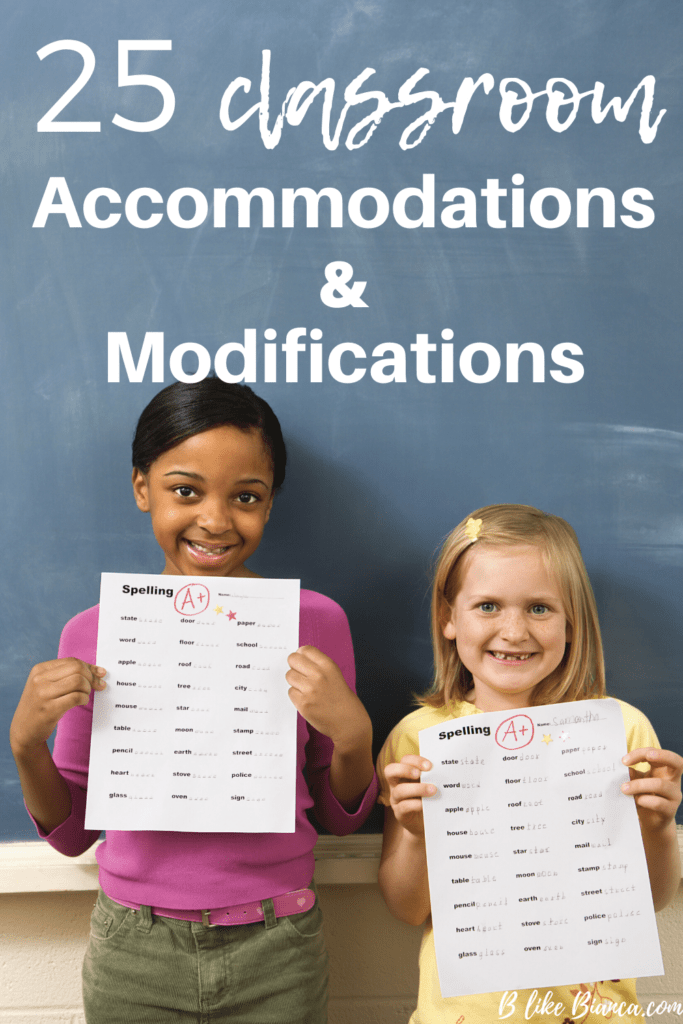According to a recent Department of Education report, there are 6.7 million students receiving special education services from ages 3 to 21. That means, 6.7 million receiving accommodations and modifications in the classroom!
At least 95% of these kids with disabilities spend at least part of their day in the general education setting, with over half of these kids spending at least 80% of their day in general education setting.
Creating the inclusive classroom is not always easy and from what I have found, many general education teachers are not prepared for learner diversity in the classroom. They are daunted with feeling like they have more work to do and instead of collaborating with special education teams, they want special educators to give all the answers.
Without regular professional development, the easiest way to breakdown how to create an inclusive classroom is with:
Accommodations
Modifications
Differentiation
Differentiation applies to tailoring instruction to meet individual needs. In applying accommodation and modifications throughout your lessons and in the classroom is differentiation.
Incorporating these things in your lesson planning, along with collaborating with your instructional teams to problem solve regularly, will assist in creating your inclusive classroom.
After interviewing 10 special education students, 9 out of 10 special education students say their favorite classroom is their special education classroom. Why? They felt they could be successful in the classroom. The goal for your classroom is for all students to feel like they are included.
The special education teacher taught at their pace and gave them chances to get better grades. The teacher listened. All students were comfortable enough to share and talk to everybody.
Teachers need to apply layers to their learning by having building on existing knowledge and sprinkling with new information.
How to Apply Accommodations/Modifications
Students with an Individualized Education Plan (IEP) or a 504 plan will need accommodations and modifications to achieve success in the general education setting. Accommodations and modifications can apply to the learning environment, instruction delivery, curriculum, or assessment.
Accommodations – Support
How a student accesses information and demonstrates what they have learned assists in removing barriers
Example: small group testing
Modifications – Change
Changes in what a student is expected to learn. Includes changes to course content, class work, or instructional level.
Example: Student completes 5 test questions instead of 10 questions.
FYI- These changes should be applied before the student receives the test

25 Accommodations and Modifications
1. Modify Assignments and tests
2. Provide an extra set of textbooks for home
3. Audio books
4. Allow extra time between classes
5. Provide seating accommodations
6. Text-to-speech
7. Speech-to-text
8. Scribe
9. Copy of notes
10. Adjustable seating
11. Use visual cues
12. Provide copy of notes
13. Able to use notes on tests
14. Able to listen to music
15. Provide choices in delivery of assignment
16. Agenda/planner/organizer/schedule
17. Behavior contract
18. Break card
19. Alternate classroom seating
20. Use modified worksheets/textbooks/workbooks
21. Frequent checks for understanding
22.Breaking material in manageable parts
23. Small group testing environment
24. Small group independent work environment
25. Multiple forms of instruction (visual, text, hands-on, games)
Bonus: Use stress balls, bendables, fidgets, or other manipulatives to help with classroom concentration. Check this posts for hands on activities for students with special needs, it may have what you are looking for.
Final Thoughts
Most general education teachers think that applying accommodations and modifications just means it will create more work for them. This is not the case at all. If you collaborate with your building’s special education teacher or even the instructional coach, it will make inclusive education more streamlined.
If you are looking for more strategies check out Reach More, Teach More eBook. It includes a full chapter on how to support 504 and special education students in a chapter titled, “Teacher don’t Ignore Me!” It also includes information in more detailed on differentiation in the classroom.
Furthermore, please don’t confuse the needs of a student’s disability as only being a behavior child without applying the necessary and law abiding accommodations and modifications. If you are having trouble with classroom management, I have some tried and true strategies that have worked with all levels of learners.
If you have any comments, please leave below or need any feedback, I am happy to assist in any way I can!
 Need a break with a classroom read aloud? Check out the playlist HERE!
Need a break with a classroom read aloud? Check out the playlist HERE! 


4 Comments on 25 Accommodations and Modifications to Apply in the Classroom